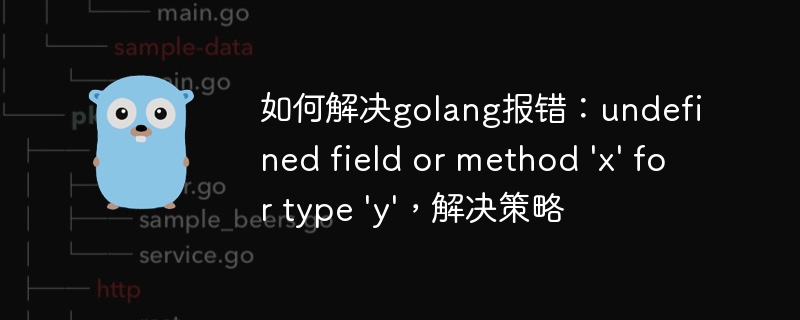Home >Backend Development >Golang >How to solve golang error: undefined field or method 'x' for type 'y', solution strategy
How to solve golang error: undefined field or method 'x' for type 'y', solution strategy
- 王林Original
- 2023-08-25 21:48:291298browse

How to solve Golang error: undefined field or method 'x' for type 'y', solution strategy
Introduction:
In the process of using Golang development, Sometimes you will encounter some error messages during compilation, such as "undefined field or method 'x' for type 'y'". This type of error usually means that we accessed an undefined field or method in a certain type. This article will introduce the common causes and resolution strategies of this error, and provide some code examples to help readers better understand and solve this problem.
- Error cause analysis:
When we access a field or method of a type, the compiler will first check whether the definition of the type contains the field or method. If the corresponding definition is not found, an error "undefined field or method 'x' for type 'y'" will be reported. This error usually has the following common causes:
1.1 Field or method spelling error:
The most common reason is the spelling error of the field or method name. In Golang, field or method names are case-sensitive, so we need to double-check whether the spelling is correct.
1.2 Fields or methods whose first letter is not capitalized:
In Golang, only fields or methods whose first letter is capitalized are exportable. If we reference an unexported field or method in another package, the compiler will report an error.
1.3 Fields or methods defined in other files or packages:
In Golang, each file belongs to an independent package. If we access in one package the fields or methods defined in other files or packages fields or methods, an error will also be reported.
- Solution strategy:
For the above reasons, we can adopt the following solution strategies to solve this problem:
2.1 Check the spelling of the field or method name:
We need to carefully check the spelling of field or method names, paying special attention to capitalization. You can use the IDE's auto-completion feature to avoid spelling errors, or use a code inspection tool to help us check spelling.
2.2 Check the exportability of fields or methods:
If we reference a field or method in other packages, we need to ensure that the first letter of the field or method is capitalized so that it can be exported. If you don't need to export, you can change the first letter to lowercase.
2.3 Make sure the field or method is defined in the current package:
If we access a field or method defined in another file or package in a package, then the definition of the field or method needs to be moved to in the current file or package.
The following are some code examples to help readers better understand and solve this problem:
package main
import (
"fmt"
"github.com/example/utils"
)
type Person struct {
Name string
Age int
}
func main() {
person := Person{
Name: "Alice",
Age: 25,
}
utils.PrintPersonInfo(person)
}// utils.go
package utils
import "fmt"
type Person struct {
Name string
Age int
}
func PrintPersonInfo(person Person) {
fmt.Printf("Name: %s, Age: %d
", person.Name, person.Age)
}In the above example, we define a Person structure and a PrintPersonInfo function. In the main function, we create a person object and pass it to the PrintPersonInfo function for printing. The code is legal and will not report an error.
I hope that through the introduction and code examples of this article, readers will have a deeper understanding and grasp of how to solve the Golang error: "undefined field or method 'x' for type 'y'", and be able to solve similar problems when encountering similar problems. Locate and resolve errors faster.
The above is the detailed content of How to solve golang error: undefined field or method 'x' for type 'y', solution strategy. For more information, please follow other related articles on the PHP Chinese website!

